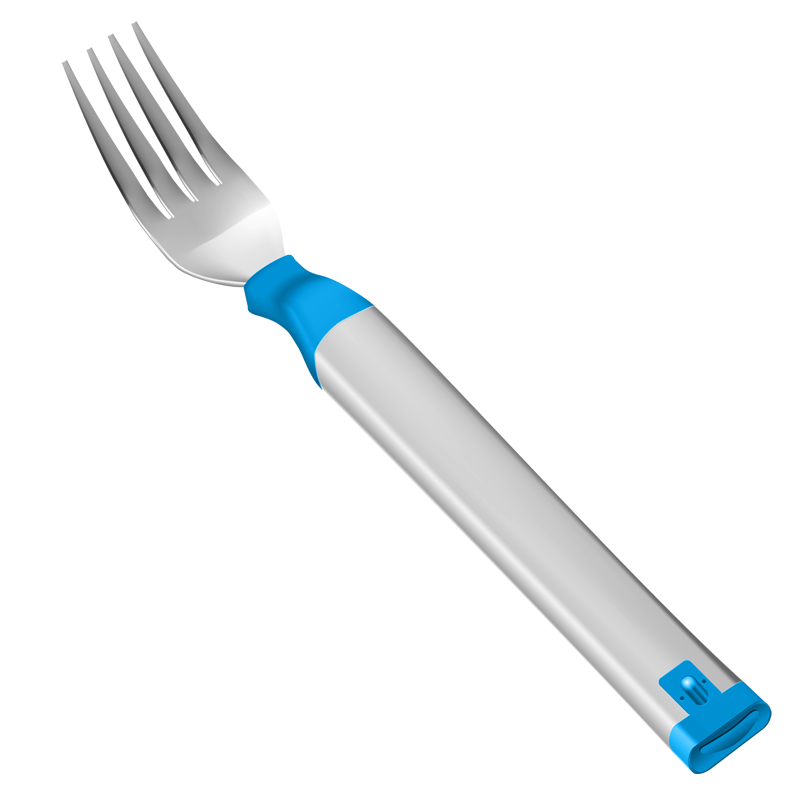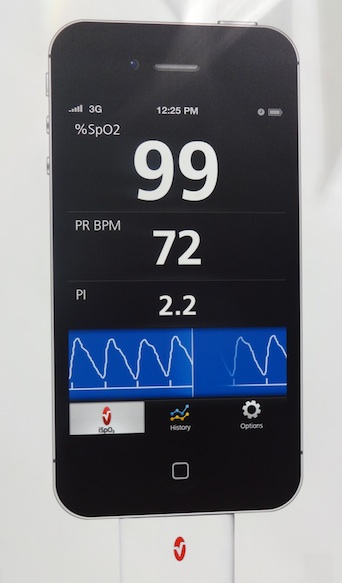
by Larry Magid
This post fist appeared in the San Jose Mercury News

One big trend at the Consumer Electronics Show in Las Vegas was connected health and fitness products to enable consumers to get in shape, control what they eat and stay on top of medical conditions.
I have a tendency to eat too fast and I know that can lead to weight gain. So the product that I’m most excited about is HapiFork from HapiLabs. It’s a regular table fork with an accelerometer and other technology that measures the exact time you start and finish your meal, the amount of “fork servings” per minute and per meal and the duration of the meal. People who eat more slowly eat 11 percent fewer calories, according to the product’s designer Jacques Lepine. Eating slowly also gives you more time to digest your food.
The device connects wirelessly to a smartphone or tablet via Bluetooth which, in turn can upload it to a website or a social media service. It also has a vibrator and indicator light that lets you know if you’re eating too fast. The fork itself detaches from the electronics so it can be washed in a dishwasher.
A USB version of the product will start shipping in February to the company’s Kickstarter backers. The Bluetooth version is expected to be available to the public in 2014 for $99.
Measuring movement
What you eat is one part of the equation of keeping fit but how much you move around is also very important. To that end, a number of companies were at CES with exercise monitors.
I tried out the Fitbug, a small pedometer that you can put in your pocket or clip to your belt that measures how many steps you take and sends that data, via Bluetooth, to a smartphone. The phone then uploads it to a website where you can track your movements over time. I always knew that I walked a lot at CES but now I can prove it. In an afternoon and the next morning, I took 17,783 steps, which according to app, equals about 5.5 miles and about 450 calories burned.
Another company, Fitbit, has an even smaller device that tracks steps but also includes an altimeter to measure stair climbing. The $99 Fitbit One also comes with a wristband that you wear while sleeping to measure your sleep patterns. At CES, the company introduced the FitbitFlex that’s built into a flexible rubber wristband that can be worn day and night. The older Fitbit One communicates wirelessly to a PC or a Mac but that requires that you plug in a small USB sensor into the computer. The new Fitbit Flex, available for pre-order for $99, uses Bluetooth to communicate through a smartphone.
Pulse and oxygen
IHealth was one of several companies showing blood pressure, blood glucose and blood oxygen monitors that connect to iPhones. The company has long offered an iPhone-connected blood pressure cuff that displays its data on the iPhone’s screen and allows you to upload it to a secure website. At their booth, I tested the new pulse oximeter that’s similar to the one my doctor users to measure pulse rate and blood oxygenation by placing your fingertip in a small sensor. Like the company’s other products, it sends the data goes to the phone and, optionally, to a secure site.

Massimo introduced a similar iSpO2 Pulse Oximeter for iOS that sends blood oxygenation, pulse rate and perfusion index to an iPhone or iPad.
Many fitness buffs like to track their pulse rate while they exercise. Traditionally, that required wearing a strap across your chest but those days are over. Withings introduced its Smart Activity Tracker, which is similar to the ones I discussed earlier but also has a sensor that can measure your pulse. Like others, it uses Bluetooth to communicate with your smartphone and the Web.
Mio was at the show with a wrist watch that dubs as continuous pulse monitor. The $199 Mio Alpha has a soft silicone strap and continuously displays your pulse while also serving as a timer and clock. Though it will be used mainly athletes wanting to makes sure their pulse is high enough while they exercise. But when I tested it, my pulse was higher it should be so I deliberately tried to relax, and immediately noticed the rate going down.
Runtastic was one of several companies showing off GPS-enabled products to track cycling and running. Products include a GPS watch with heart rate monitor and arm bands and bicycle mounts for smart phones.
As I get ready to leave Las Vegas, I’m looking forward to trying out some of these products — especially the ones that measure sleep — an activity I got very little of during this hectic trade show.